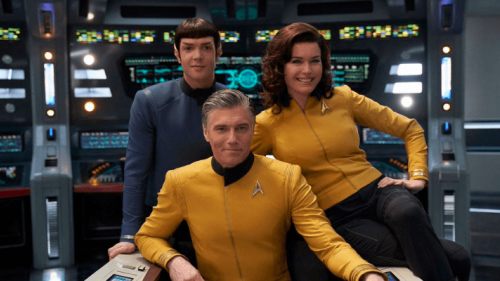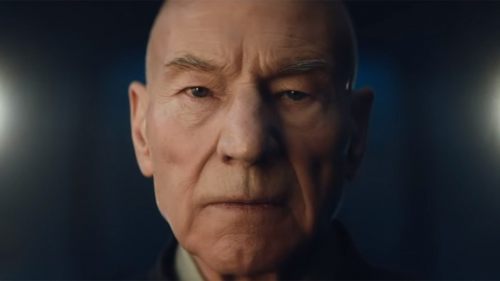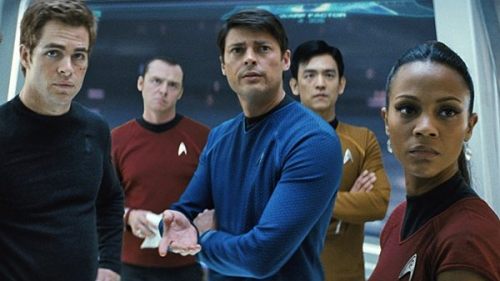Reach The Limits Of The Universe And Evolve: STAR TREK: THE MOTION PICTURE Turns Forty
“That was boring,” I clearly remember saying as the end credits rolled on Star Trek: The Motion Picture at our local cinema in December 1979 in what I can now identify as my first conscious act of film criticism. I wasn’t alone in this opinion: the words on the screen might have said “The human adventure is just beginning” but for much of the audience the afternoon nap was just coming to an end. My mother and grandmother, who I’d pestered into taking me, took my capsule review in good grace, but I was too disappointed to notice I was being an ungrateful brat.
Growing up, our house was always full of science fiction, and not just in book form: we watched Flash Gordon serials, Gerry Anderson’s retrofuturistic puppet shows and every SF movie we could find, while on the BBC Tom Baker was in his bescarfed Doctor Who pomp opposite the gritty space opera of Blake’s 7. It was the Star Trek reruns though, 79 episodes of what we now call The Original Series in apparently never-ending rotation, that taught us how any problem could be resolved with the mixture of intellect, empathy and morality embodied by Mister Spock, Doctor McCoy and Captain Kirk.
My Dinky model of the USS Enterprise was my most treasured toy even as its warp nacelle pylons sagged and its photon torpedoes got lost, crossing over with my View-Master and its tiny stereoscopic images of strange new worlds when the huge marketing campaign for Star Trek: The Motion Picture released a three-reel set before the film was even out. In the days before instantly-streamed trailers, this was as much of the movie as we could see in advance, and while my set was supposed to be a Christmas present, pester power meant I could open it early and commit them to memory. You can find scans of them online today, twenty-one 3D images with captions that sound exactly like an excitable schoolyard synopsis: this movie was going to be awesome.
That it wasn’t is the first time a movie disappointed me, and I don’t think it’s a stretch to say that trying to figure out exactly how and why is but one reason I find myself writing articles like this today.
I didn’t understand the characters’ frequent blurry halos, only later coming to understand director Robert Wise’s use of split diopter to precisely control their prominence and focus in the frame. My six-and-three-quarter-year-old mind had no conception of what Ilia’s celibacy vow meant, nor how her presentation as exotic forbidden fruit was intended as an injection of sex appeal. Gorgeous as the Starship Enterprise’s exterior was, its beige interior and the crew’s pastel uniforms felt less like the far future than the recent past, and it was years before I appreciate the production design’s efforts to make the ship less warlike.
Mainly I was confused by the movie’s ponderous self-importance, the incomprehensible scale of its amorphous attacking space cloud, and why most of it didn’t look anything like my View-Master reels, all of which I now recognise as manifestations of problems behind the scenes, where too many cooks were up against an immovable deadline. Star Trek creator and producer Gene Roddenberry wanted to give his baby the gravitas of 2001: A Space Odyssey, but studio Paramount was chasing that Star Wars coin while director Robert Wise tried to make a character-driven drama. Their squabbling ate up valuable time but Paramount had pre-sold the film to theaters with a guaranteed December 7th 1979 release date, and delays to the special effects and score meant the film was barely finished in time for its premiere, and released to cinemas untested and untweaked.
Forty years later, the resultant flaws are still apparent. I might now use more sophisticated critical vocabulary, say the film is deliberately paced rather than boring, but that doesn’t change the way it comes to a dead halt as Scotty takes Kirk on an inspection tour of the Enterprise. Kubrick uses similar shots in 2001 to establish the isolation and topography of Discovery One, also filmed by Douglas Trumbull, but The Motion Picture instead wallows in five minutes of raw fan service, expecting us all to be that backflipping spacedock worker. The same happens when Spock docks with the Enterprise and again at even greater length as the Enterprise enters the V’Ger vessel: spliced into the movie directly from Trumbull’s studio, the special effects become the story rather than its enabler.
The script doesn’t entirely hide its TV series pilot origins either and fails to latch onto a tone in the first act, but then something magical happens: Spock, Kirk and McCoy are reunited in the officers’ lounge and suddenly The Motion Picture becomes unalloyed Star Trek. Just as Spock rebalances the warp engines, the restoration of the trinity rebalances the film and it settles into the familiar groove of the series as they apply their distinct talents to understanding the what and why of V’Ger.
Taking a lost Voyager probe as its central conceit, returning to Earth in search of its creator after being taken in as a foundling by machine intelligences, not only spoke to classic Star Trek episodes such as The Changeling while trading on the 1979 public’s familiarity with the Voyager 1 and 2 probes after they beamed images back from Jupiter (in turn used as reference for the movie), but finally presents the The Motion Picture with a way to fuse 2001 with Star Trek, the effects telling the story as Spock journeys through his own stargate.
“V’Ger is asking questions,” Spock tells Kirk. “Is this all that I am? Is there nothing more?” Answering by simply grasping his friend’s hand, he exposes the core of the Star Trek philosophy: for all its flaws, humanity is inherently valuable and worth fighting for. Leonard Nimoy is at his finest in this scene, subtly layering Spock’s Vulcan logic and human emotions, just as William Shatner allows Kirk a degree of fragile self-doubt in his encounters with Commander Decker, foreshadowing the recurring theme of youth versus age in the next five Star Trek movies.
“V’Ger is that which seeks the Creator: the Creator is that which created V’Ger,” the false Ilia tells Kirk before he punctures its circular logic with the revelation that the “carbon units which infest Enterprise” are the Creator. While awash with religious imagery, The Motion Picture answers the question it poses of the creator’s responsibility towards their creation in a firmly secular ascension as Decker becomes one with V’Ger, leaving this plane of existence in a spectacular depiction of transhumanism at the moment of conception.
Tackling such broad philosophical ideas through the lens of science fiction is key to Star Trek, yet The Motion Picture received poor reviews for doing exactly that, and the “boring” opinion I shared as a child was widespread. As its 1982 sequel The Wrath Of Khan would show, audiences wanted action too.
Seen through adult eyes, the truth is more complex: yes, the movie has pacing problems and suffers a lack of character drama, but the ideas at play are fascinating and its spaceship shots are still hugely impressive. Robert Wise re-edited the film in line with his original vision in 2001, and in striking a better balance between special effects and character moments this Director’s Edition reveals Star Trek: The Motion Picture to be a magnificent piece of pure science fiction cinema.
In the meantime, a Curse Of The Odd-Numbered Star Trek Movie had been identified among the less well-received entries. They might ultimately appeal to a narrower audience, but by continuing to seek out new life and boldly go where no-one has gone before these movies stay true to the values of Star Trek and are all the better for it. The truest of them all is Star Trek: The Motion Picture.



